« January 2008 | Main | March 2008 »
February 28, 2008
Morenci Mine, Arizona 2008
The obvious benefit about the retirement travel style that Bernie and I have chosen is the amazing things we have seen. Tiananmen Square in Beijing, the Marjorie Glacier in Alaska and the Grand Canyon are just 3 of dozens of memorable places we have visited and shared with you in our journal.
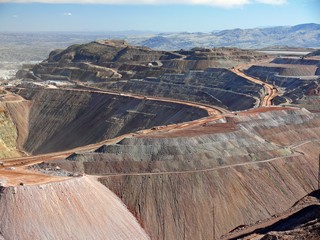
Near the end of our visit to Arizona this winter, we journeyed to Clifton in the east central part of the state, near the New Mexico border, to take a tour of the Morenci Mine – the largest open pit mine in the contiguous U.S. Owned for over 70 years by Phelps Dodge, the company was sold about a year ago to Freeport-McMoRan Copper and Gold Inc., for a reported $26 billion.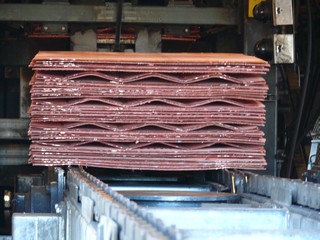 There are about 2,000 employees at this one mine which produces approximately 8% of the world’s supply - 2.3 million pounds of 99.9% pure copper EVERY DAY, 365 days a year, 24 hours a day. There is an expression is the US south-west that everything is bigger in Texas. Well, there’s nothing this big in Texas. As we rode on the tour (and then again on our own the following day), we travelled about 13 kilometers (8 miles for our American friends) of US highway 191, all of it within the active mine property.
There are about 2,000 employees at this one mine which produces approximately 8% of the world’s supply - 2.3 million pounds of 99.9% pure copper EVERY DAY, 365 days a year, 24 hours a day. There is an expression is the US south-west that everything is bigger in Texas. Well, there’s nothing this big in Texas. As we rode on the tour (and then again on our own the following day), we travelled about 13 kilometers (8 miles for our American friends) of US highway 191, all of it within the active mine property. 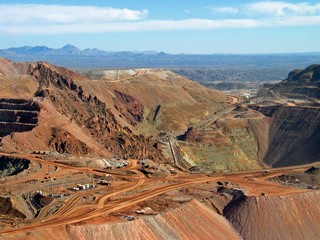 As the pictures show, the scale of this operation is vast. Man-made mountains of ore sit side by side with natural mountains of the same height. These holes in the ground make the hole for the foundation of the CN Tower look like just a spoon full. We were told that one leaching bed (more about that in a moment) was 500 acres (a typical Ontario farm is 100 acres) and it certainly wasn’t the biggest we saw.
As the pictures show, the scale of this operation is vast. Man-made mountains of ore sit side by side with natural mountains of the same height. These holes in the ground make the hole for the foundation of the CN Tower look like just a spoon full. We were told that one leaching bed (more about that in a moment) was 500 acres (a typical Ontario farm is 100 acres) and it certainly wasn’t the biggest we saw. 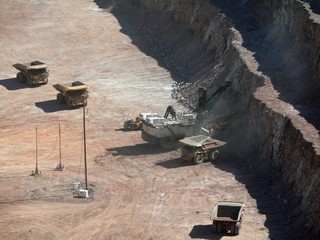
The mountain side is blasted and then dug by huge electric shovels. Three scoops of the shovel fill one haul truck – with 240 tons per load. The tires you see in the photos are 12 feet in diameter, 6 per truck, the engine is a V16 2000 hp, and the ore box on the back is 24 feet wide. Each truck costs around $2,000,000.
The trucks drive left handed (opposite to normal highway driving) which puts the drivers on the outside of the directi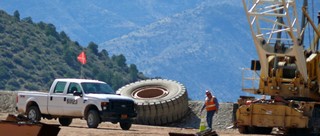 on of travel, to protect them if there is an accident. The company is currently assembling 5 trucks for testing which will carry even larger loads. These haul vehicles are so big they cannot be built in a factory, so they assembled on site (kind of the ultimate Lego kit!!!). The trucks are loaded by the power shovel at the ore face and then drive to the crusher, a 5 – 15 minute round trip. The trucks move 700,000 tons of raw ore every day. You will notice in the photos that the roads are as big as a new highway.
on of travel, to protect them if there is an accident. The company is currently assembling 5 trucks for testing which will carry even larger loads. These haul vehicles are so big they cannot be built in a factory, so they assembled on site (kind of the ultimate Lego kit!!!). The trucks are loaded by the power shovel at the ore face and then drive to the crusher, a 5 – 15 minute round trip. The trucks move 700,000 tons of raw ore every day. You will notice in the photos that the roads are as big as a new highway.
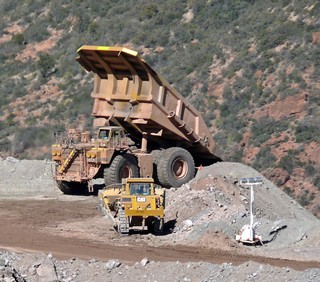
That’s a standard size bulldozer in front of the haul truck.
The ore is dumped and crushed into uniform size and then transported to the site being developed for leaching. Large pipes (3 feet diameter) are installed at the site, with progressively smaller pipes and hoses spreading out across the surface. 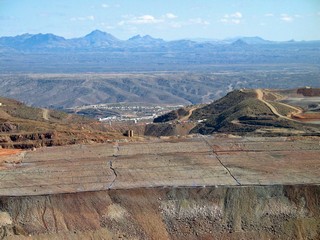
The ore is extracted by leaching, which involves soaking the bed through the pipe system with a solution of water/sulfuric acid, which seeps down through the ore over a period of several months, into a pond at the bottom edge of the leaching field, carrying the copper in the solution. 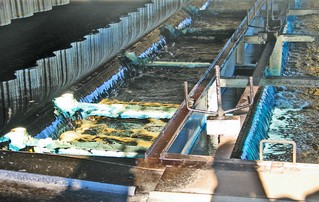
The solution is then piped to the extraction department where 5 tanks, each about the size of a large swimming pool, wash and separate the water, sulfuric acid and copper through chemical processes until only the copper is left. It then goes into a concentration process which ultimately results in nearly pure copper sheets (the second photo above)which are then shipped to refineries across the U.S. and Canada for manufacture into copper products such as wire and pipe.
The other very interesting aspect of our visit to the Morenci mine was the town of Morenci itself which is just “up the hill” to the north of Clifton. It is not an incorporated independent community like most others – it is a company town. The mine owns it all: the land, schools, homes, office 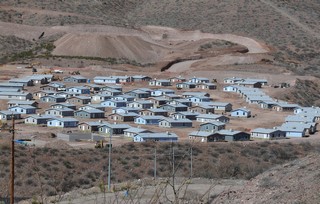 buildings, motels, supermarkets, hospital and everything else. They don’t own all the businesses; many enterprises are operated by tenants in space leased from the company. Most employees live in homes on the town site which they rent from the company for about $200.00 a month. Although they are all pretty much the same, they have their own individual appearance and style and the residents have all the various interests you would find anywhere else. BUT, if the town gets in the way of the mine, the TOWN gets moved and it has happened – twice. Everything gets moved, except the cemetery. On the tour we were shown one of the former sites, which is now largely covered with ore tailings. As we arrived in Clifton we could see another company home subdivision nearing completion.
buildings, motels, supermarkets, hospital and everything else. They don’t own all the businesses; many enterprises are operated by tenants in space leased from the company. Most employees live in homes on the town site which they rent from the company for about $200.00 a month. Although they are all pretty much the same, they have their own individual appearance and style and the residents have all the various interests you would find anywhere else. BUT, if the town gets in the way of the mine, the TOWN gets moved and it has happened – twice. Everything gets moved, except the cemetery. On the tour we were shown one of the former sites, which is now largely covered with ore tailings. As we arrived in Clifton we could see another company home subdivision nearing completion.
Because of the high price of copper on world markets, business is good. The company is currently hiring almost every type of skilled labour but there is no place to live. Even the RV park is virtually full of mine employees. The park we stayed in had kept 2 sites for travellers like us, out of 55 sites total.
The tour was over 3 hours and was amazing!!!
As noted above, we retraced the tour route the next day and continued further north up the highway. Trailers are not allowed on this road due to the steep grades and switchbacks.
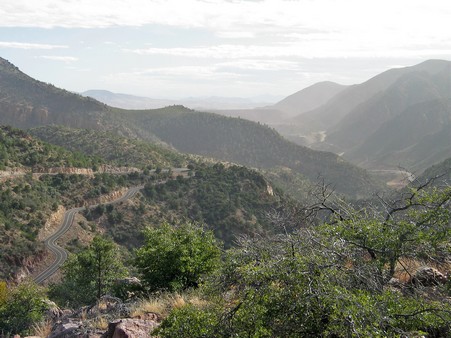
We had a wonderful vista from one of the outlooks. That’s the road winding down on the left and then disappearing in the distance.
We hope you’ve enjoyed this special journal.
Ross
Posted by Bernice at 08:01 PM | Comments (5)
February 25, 2008
Arizona 2008
It’s been cold this winter. Yes, yes, I know it hasn’t been as cold as in Ontario, but we came south to stay warm. In Silver City, it was below freezing most nights so we travelled south to within a 1/2 kilometer of the Mexican border to Naco, Arizona. It was below freezing the first night we were there. Oh well, at least I’m not shovelling snow!
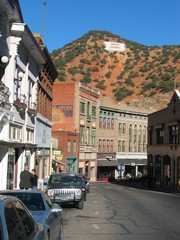
Bisbee, AZ is about 15 miles north of Naco, and is the main reason that we came into this area. We were here 2 years ago (see the journal February 2005) and enjoyed the town so much we decided to come back for another visit.
This old copper mining town, originally founded in the last half of the 1800’s is now a haven for artists, sculptors and other artisans. Old buildings have been lovingly and quite authentically restored.
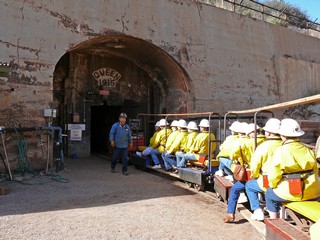 The Copper Queen Lode was the basis of the community but all the mines closed in the early 1970’s. The town now runs tours of the mine, so we decided to don hats, slickers and lamps and head underground for the 1 1/2 hour tour. The tours are given by miners who actually worked in the mines so you get a very personal and knowledgeable picture. We travelled by tram into the mountain – about 1,500 feet and into various caverns that were formed by the removal of the ore. At one point we all turned off our battery powered lamps – now that is dark!
The Copper Queen Lode was the basis of the community but all the mines closed in the early 1970’s. The town now runs tours of the mine, so we decided to don hats, slickers and lamps and head underground for the 1 1/2 hour tour. The tours are given by miners who actually worked in the mines so you get a very personal and knowledgeable picture. We travelled by tram into the mountain – about 1,500 feet and into various caverns that were formed by the removal of the ore. At one point we all turned off our battery powered lamps – now that is dark!
During it’s 100 years of operation the mine produced more than eight BILLION pounds of copper as well as substantial amounts of silver, lead zinc and gold – one of Arizona’s richest mines. Bisbee’s mines, including the Queen Mine, have more than 2,500 miles of tunnels.
Our next stop was Tucson where we set up camp for two weeks. My sister Joan, who lives in Fredericton, NB is there for a couple of months so we had great visits with her. We also visited the casinos, played golf a couple of times, had great Mexican food, attended a “Canadian” pot luck at the park, visited the Tucson Museum of Art, attended the Gem and Mineral Show, got a haircut, had the trailer washed and in general relaxed and enjoyed ourselves.
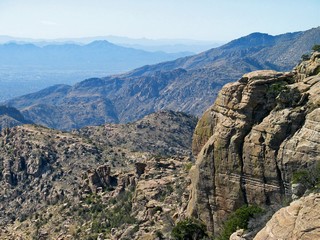 One day we drove the 30 miles to Mount Lemmon, which is in the Santa Catalina Mountains to the north of the city. At 9,157 ft., the highest mountain in the area offers both downhill and cross country skiing. The day after we had arrived in Tucson, there was a major snow storm and the road was closed until plows could finally clear it. Even in the summer the temperature is 20 – 30 degrees F lower than in the valley.
One day we drove the 30 miles to Mount Lemmon, which is in the Santa Catalina Mountains to the north of the city. At 9,157 ft., the highest mountain in the area offers both downhill and cross country skiing. The day after we had arrived in Tucson, there was a major snow storm and the road was closed until plows could finally clear it. Even in the summer the temperature is 20 – 30 degrees F lower than in the valley.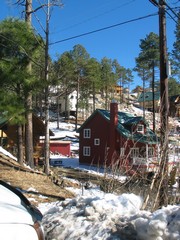
The mountains are very rugged and barren until you get to the higher elevations, where first shrubs, then finally trees are present.
Just before the ski area is the resort town of Summerhaven. The village has been a haven from the high summer temperatures since the early 1900’s. In 2003 it was devastated by the Aspen fire that burned 84,750 acres and destroyed 340 of the 450 homes and businesses. It’s amazing how these huge fires can skip individual homes and trees and consume others. No rhyme or reason. The town is gradually rebuilding but there is still little permanent population, although we did see signs for new condominiums.
We said goodbye to Joan and made for Apache Junction just east of Phoenix on Monday February 18th. We like Phoenix, we like it’s people and we like it’s atmosphere. We are very impressed by the landscaping along its roads and streets. They don’t try to grow grass – it’s desert – but they do use the native cactus and shrubs effectively.
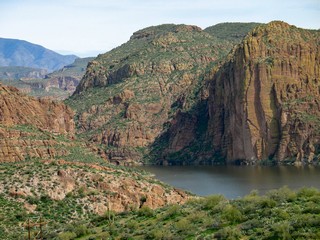 We spent one day driving The Apache Trail which was created in 1905 to transport supplies to the construction site of Roosevelt Dam. The road follows the ancient route of the Apaches through the Salt River Canyons. It runs north east for 41 miles from Apache Junction to Roosevelt through rugged, beautiful steep sided canyons, rock outcroppings and mountain vistas. You need to allow about 4 hours to do the drive.
We spent one day driving The Apache Trail which was created in 1905 to transport supplies to the construction site of Roosevelt Dam. The road follows the ancient route of the Apaches through the Salt River Canyons. It runs north east for 41 miles from Apache Junction to Roosevelt through rugged, beautiful steep sided canyons, rock outcroppings and mountain vistas. You need to allow about 4 hours to do the drive.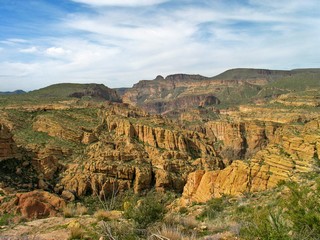
It’s best to travel from west to east as the secure rock walls will then be beside you rather than the steep cliffs on the other side. The road is paved for the first half, but the last part is gravel and very challenging with most of the road with a speed limit of 15 mph. On one curve we were able to see the wrecks of 5 vehicles in the canyon below.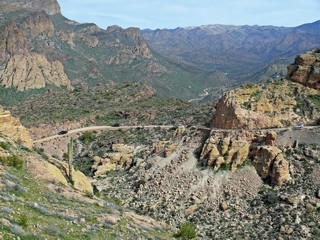
The road down into Fish Creek Canyon drops 1,500 feet in about 2 miles and hangs on the side of the canyon. It is mostly one lane, with widened spots to allow cars to meet. In the picture to the right, the road is in the foreground and also in the centre back. (It looks more like a river)
But the scenery is beautiful and we are glad we took the time to drive it. 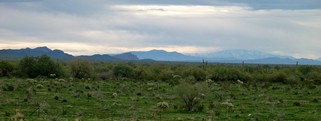
We left the Phoenix area heading east and then south east. We had been noticing how green the desert was this year. What a difference rain makes!
Our next destination is Clifton, Arizon which is on the very eastern side of Arizon. It’s there we find the huge Morenci copper mine which is where we are headed.
Bernie & Ross
Posted by Bernice at 10:35 PM | Comments (4)
February 05, 2008
Home in Jan 2008 then back to the south U.S.
We arrived back in Canada, at the Waterloo Airport and were greeted by our whole family. Barnaby and Michelle were there with their adorable 2 1/2 month old Timothy. Also there, were Mandi, Quincy and our great 2 year old, Ricky. Mandi had arrived in Cambridge in early December as she was expecting their 2nd child (scheduled for Jan 3rd). Quincy and Ricky joined her on December 27th.
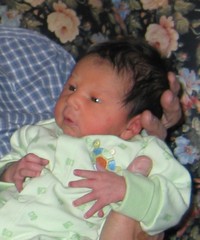
Aiden Nathaniel Walker arrived just before 3 p.m. on January 3rd. – 7 lbs 2 ozs, 20 1/2 inches and with a full head of beautiful black hair.
As planned, it was good to be home to help Mandi when she got out of the hospital and it gave us a great opportunity to spend time with both families.
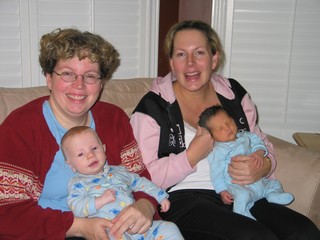
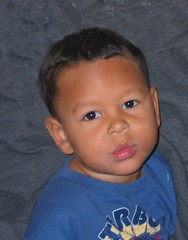
We are very blessed!!
We spent 2 weeks at home and thoroughly enjoyed our time with everyone. Quincy and Ricky returned to the Bahamas on Jan.13th and we returned to the Dallas area and our trailer on Jan 17th. Mandi remained in Cambridge until the end of the month when she and Aiden also returned home to the Bahamas.
After spending a day in Grapevine shopping, we travelled to Las Cruces, New Mexico to meet up with friends, Heather & Tony. While in the area we went to Old Mesilla to restock our supply of Bronco Bob’s Raspberry Chipotle that Bernie loves. We get it at “Solamente de Mesilla”, a great little shop run by Ron & Janyce Leone. Stop in if you are in the area and tell them that we sent you. You’ll get a great reception!
The four of us visited the Farm & Heritage Museum. It’s on 47 acres and is a mini working ranch. We took in the milking demonstration and Bernie found it interesting to see exhibits in the museum that included milking machines that she had used when she was growing up on the farm. Unfortunately, we had a defective memory card, so no pictures of our visit.
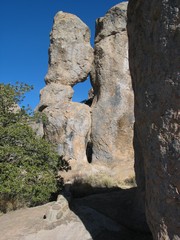
Friday, Jan 25th we all headed northwest into the mountains to the mining town of Silver City.
On the way we stopped at the “City of Rocks” State Park. Millions of years ago the volcanic rock was thrown up and then sculpted by wind and water into unusual shapes. These ones looked like they were kissing.
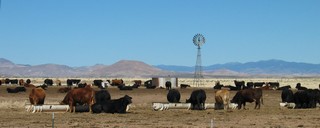
As we travelled, we crossed a huge flat valley where there were large herds of cattle. Often, they were gathered around the windmills which are used to pump water to the drinking tanks.
Silver City was the site of a rich silver strike in 1870. The town was saved from the fate of many other western mining towns – fire. An ordinance in 1880 prohibited frame construction so solid well built homes and businesses were constructed from brick from a local plant. Although the silver boom ended in 1883 the town recovered with cattle ranching, teaching facilities and later new mineral discoveries.
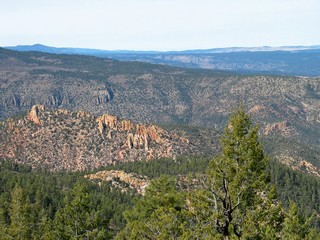
On Saturday the 26th, along with Heather & Tony, we headed further into the mountains to see the Gila Cliff Dwellings. It was only 45 miles but with the twists and bends, many at 15 and 20 mph. it took us close to 2 hours to get there. It is hard to describe the vastness of the Gila Wilderness where the three forks of the Gila River originate. With over 558,000 acres its designation as a wilderness, means that the character of the area will not be altered by the intrusion of roads or other evidence of human presence.
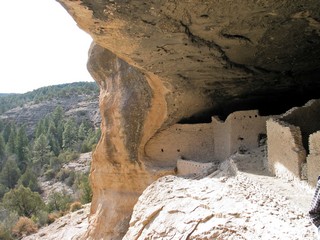 The Tularosa Mogollon (Muggy-own) people built these structures in caves with rock, mortar and timbers. The evidence indicates that these dwellings were only used from the late 1270s and were deserted by 1300. More questions than answers surround these buildings – were they residences or was it a ceremonial site; why such a short duration of use; why did they build in caves and what caused them to leave. We’ll probably never know, but walking through these dwellings gives us a little glimpse into a past civilization.
The Tularosa Mogollon (Muggy-own) people built these structures in caves with rock, mortar and timbers. The evidence indicates that these dwellings were only used from the late 1270s and were deserted by 1300. More questions than answers surround these buildings – were they residences or was it a ceremonial site; why such a short duration of use; why did they build in caves and what caused them to leave. We’ll probably never know, but walking through these dwellings gives us a little glimpse into a past civilization.
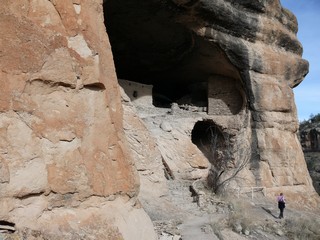
We walked the one mile loop up to the cliff dwellings and although from outside it looks like three separate entrances, in fact it is one huge cavern. There are around 40 rooms interconnected, some two stories high. We were able to walk all through the structures. To get an idea of the size of these caves – look at the picture, in the bottom right corner. That is Heather, dwarfed by the cliff.
The next day in the afternoon, it rained, and rained and rained some more. We went art gallery hopping in the late morning and had planned on doing the historic walking tour in the afternoon – but the rain got in the way. We drove it instead. Now, following a map by car, that is intended to be walked is a challenge. You don’t have “One Way” streets when walking, and foot bridges won’t carry cars. We saw more of the city than we had planned.
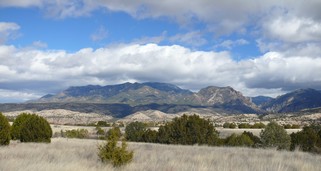 The sun came out the following day and with Tony & Heather we headed toward The Catwalk in Whitewater Canyon. The drive was wonderful – good road, spectacular views and great weather. This view is from Leopold Vista looking east to the Mogollon Mountains.
The sun came out the following day and with Tony & Heather we headed toward The Catwalk in Whitewater Canyon. The drive was wonderful – good road, spectacular views and great weather. This view is from Leopold Vista looking east to the Mogollon Mountains.
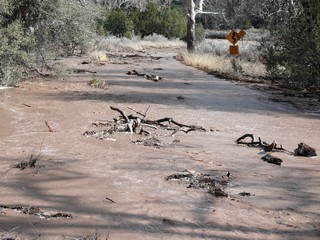
Just past Glenwood, we turned up the Canyon road to be faced with “Road Closed”. We walked down past the barriers to find the road washed away and water, mud, branches, rocks and logs covering the normally dry pavement. A local resident said that she had never seen the river this high in her 24 years of living there.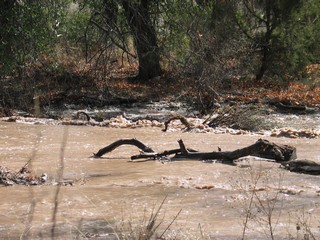
We walked further along the river watching as the water roared past, carrying huge logs, rocks and boulders, trees and bushes. Knowing how destructive water can be we kept well back from the edge as we could see small parts of the banks being undermined and swept away.
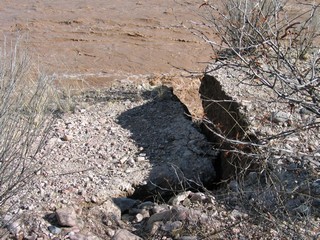 We were glad we had stayed back as Bernie felt the ground move, looked down to see a crack opening up just in front of her feet and another just behind her. She jumped back and we watched as a huge section of the bank – probably 25 – 30 ft long and about 5 feet wide, slowly separated and then dropped about 3 feet to the river. An earth moving experience!
We were glad we had stayed back as Bernie felt the ground move, looked down to see a crack opening up just in front of her feet and another just behind her. She jumped back and we watched as a huge section of the bank – probably 25 – 30 ft long and about 5 feet wide, slowly separated and then dropped about 3 feet to the river. An earth moving experience!
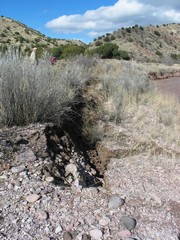
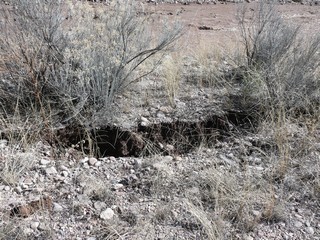
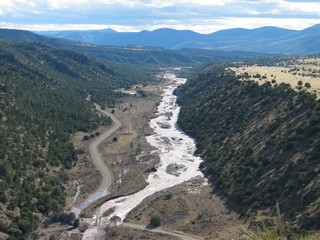
Since we couldn’t get to the Catwalk (a suspension walkway in a narrow canyon) we travelled further up the road and hiked a trail where we could look down into Whitewater Canyon. We could see that up this far the river covered the road and bridge, again cutting off access.
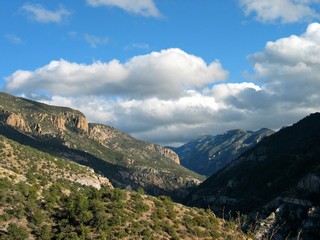
The mountain views that we were rewarded with, once we had hiked to the top, were awesome. The air was so clear and fresh and the silence was total. We didn’t even hear birds.
The next morning, we found out that the rain had also washed out the road and bridge to the Gila Cliff Dwellings, totally isolating the area we had just visited two days previously.
We said goodbye to Tony & Heather that morning, as they were heading further into New Mexico and we were travelling west to Arizona. We’ll stay in touch and meet up with them again somewhere along the road. That’s typical of this lifestyle we have.
Bernie & Ross
Posted by Bernice at 08:52 AM | Comments (2)